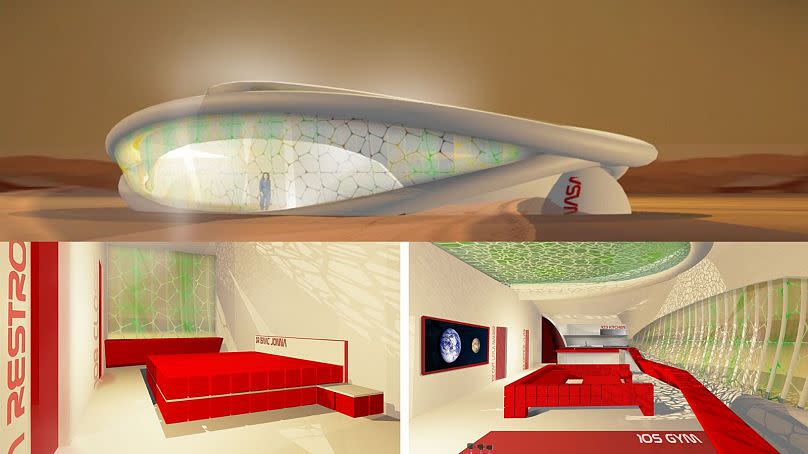Humans settling on the Moon and Mars in the future may live in homes 'grown' from mushrooms

They will one day be homes for humans on the Moon or Mars, but for now, the first test extraterrestrial habitats are being built on Earth with the help of an unexpected material: mushrooms.
American architecture firm Red House is working with NASA and the Massachusetts Institute of Technology (MIT) Center for Bits and Atoms to build new bio-habitats - homes made from living organisms - in space.
Red House is mixing the waste biomass from Namibia’s infamous "encroacher bush" - an invasive species that drains groundwater, causing fertile areas to become deserts - with mycelium, a fungus whose structure is an underground network of connecting fibres.
The aim is to create food and in this case, a sustainable building material that is reportedly stronger than concrete.
Mycelium has unique properties "that act like a glue to bind substrates [such as construction debris and plants] together," Christopher Maurer, founder and principal architect at Red House, told Euronews Next.
How do you 'grow' homes on Mars?
Biomass will be trickier to produce in outer space, however, "because there's no biology… nothing for mycelium to grow on," says Maurer.
But the firm has been determined to create an extraterrestrial design using materials from waste streams here on Earth.
They envision an uncrewed mission arriving on Mars with a folded shelter contained inside a sealed bag with dehydrated algae (more specifically chaetomorpha, or sea emerald as it is known) and dormant mycelium.

Once in situ, a rover vehicle on Mars’ surface would inject carbon dioxide, nitrogen, and water sourced from the Red Planet into the sealed bag to rehydrate the algae.
"It's like blowing up a balloon," said Maurer.
The reaction will produce oxygen which will replenish the structure while at the same time nourishing the mycelium.
The mycelium will then grow and expand into its desired structural shape and fuses with the algae to form a rock-hard biomass.
The "growth" of the houses would be fairly quick, he added.
"In a dream scenario, it could be erected in a matter of hours or even minutes if you had the right kind of pressure pumping into it. Then, creating the solid, dry biomaterial that becomes insulating would ideally take four weeks".

Stronger than concrete and radiation repellent
The fungus-bonded biomass is not only remarkable for its capacity to leave Earth as a very small folded mass that then turns into “tons and tons of material” at the destination, but it can also "convert high energy radiation, which is our main liability [on Mars], into a resource for creating more biomass".
"Radiation is the main thing that prevents us from going to go to Mars," explained Maurer, adding that research has shown the capabilities of mycelium to work as a protective layer from radiation "at higher levels than most materials".
The project team is building "an organism at a macro scale," says Maurer. "We're almost designing the architecture for the microbes, and then they're forming the architecture".
Can mushrooms really make a home?
Maurer says they have already posed the question to NASA’s planetary protection experts, "and they kind of looked at it and said it looks okay".
"We’re just growing the mycelium… and there are all kinds of different species that don't produce mushrooms. They can't make spores, which is usually the problem with molds and things like that," he told Euronews Next.
Ultimately, the sealed container carries fewer risks compared to sending humans inhabited by millions of microbes with a huge microbiome that would be impossible to sterilise, he says.

When will mushrooms help colonise the Moon or Mars?
So, when are we likely to see mushroom-based dwellings on either the Moon or the Red Planet?
"If we get moonshot money then we can do it in a matter of years because we have a lot of the parts in place. But if we continue at the pace we're doing there, waiting for technology to trickle in from all over, it can be decades," Maurer said.
However, Red House’s prototype has already passed the proof of concept phase at NASA's innovative advanced concepts (NIAC) and is currently in phase two, what they call architectural design development. Phase three would be a small demonstration.
The architecture firm is also preparing to send a small 15x15 cm model of their prototype to the Moon using NASA’s Commercial Lunar Payload Service (CLPS), which offers private companies the ability to land on its surface and bring scientific instruments.
The prototype will travel to the Moon "in a kind of a sealed container that we'll have water and carbon dioxide for feeding the algae, that will then create oxygen that feeds the funghi".
The large-scale, long-term mission would need NASA to be able to source water, potentially on Mars’ surface.
Are there applications for mushroom architecture on Earth?
Beyond space exploration, Maurer thinks the technology could "open architecture to be able to do new things…building in a way in which you can actually store carbon rather than emit carbon".
In the same way that reinforced concrete changed the way we build structures, "this makes a better, almost a reversal, on the carbon footprint that modernism had".
The world’s building stock is responsible for 40 per cent of the planet's carbon footprint, "so if you could reverse that, you could see a huge, huge change in the way that we're putting carbon in the atmosphere".

 Yahoo Sport
Yahoo Sport 





































